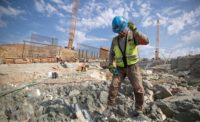A comprehensive panel discussion covering lessons learned during last spring’s spillway failure at Oroville Dam was a highlight of the annual Dam Safety conference, hosted by the Association of State Dam Safety Officials in San Antonio, Sept. 10-14.
“There were a number of competing threats and challenges at Oroville,” said William Croyle, who was acting director of the California Dept. of Water Resources, the dam owner, at the time of the incident (he has since retired). “We realized that sometimes mitigation of one threat would increase risk elsewhere.”
Coordination of the many parties during the crisis was key. In addition to DWR, state emergency services and local law enforcement, there were two dam-safety authorities on site, the state division of dam safety and the Federal Energy Regulatory Commission. “We worked very closely as regulators to give consistent requirements to the owner,” said Sharon Tapia, chief of dam safety at DWR. Conversely, “transparency was important—making sure the regulators had access to information during the incident,” said Croyle.
Croyle echoed Tapia’s emphasis on coordination. “At the outset, [Butte County Sheriff Korey] Honea and I stepped into a room and were able to reach agreement on how to work together in 10 minutes. It got us through this very difficult event.” Honea was the lead law- enforcement agent during the incident.
The event spurred one significant regulatory change. Prior to the incident, dam owners were required to submit only a single inundation map at the time a dam was built, and emergency action plans were not required. Over time, those maps could become outdated. Signed by Gov. Jerry Brown (D) and becoming law in June 2017, legislation now requires current emergency action plans and inundation maps for dams and large appurtenant structures, such as spillways, explained Tapia.
In retrospect, the officials would have adopted a somewhat different strategy for communicating with the public during the ongoing crisis. “For example, a lot of people proposed unworkable solutions via social media, such as putting crushed-car bodies in the erosion crater,” said Croyle. “These people got attention from local officials and took us off our public safety mission. In hindsight, we should have had more staffers refuting inaccurate facts right from the start.”





Post a comment to this article
Report Abusive Comment